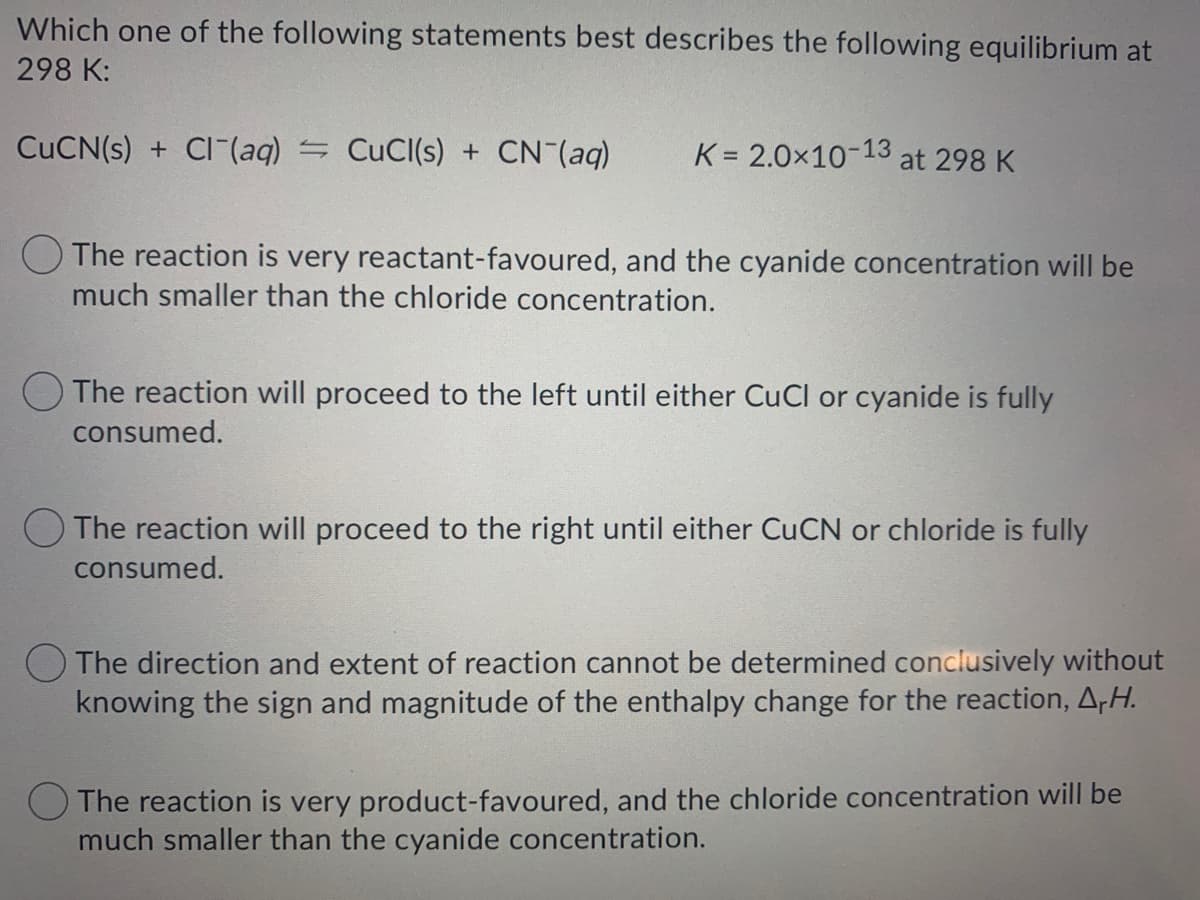Which one of the following statements best describes the following equilibrium at 298 K: CUCN(s) + CI (aq) = CuCl(s) + CN (aq) K = 2.0x10-13 at 298 K O The reaction is very reactant-favoured, and the cyanide concentration will be much smaller than the chloride concentration. O The reaction will proceed to the left until either CuCl or cyanide is fully consumed. O The reaction will proceed to the right until either CUCN or chloride is fully consumed. The direction and extent of reaction cannot be determined conclusively without knowing the sign and magnitude of the enthalpy change for the reaction, A-H. O The reaction is very product-favoured, and the chloride concentration will be much smaller than the cyanide concentration.
Which one of the following statements best describes the following equilibrium at 298 K: CUCN(s) + CI (aq) = CuCl(s) + CN (aq) K = 2.0x10-13 at 298 K O The reaction is very reactant-favoured, and the cyanide concentration will be much smaller than the chloride concentration. O The reaction will proceed to the left until either CuCl or cyanide is fully consumed. O The reaction will proceed to the right until either CUCN or chloride is fully consumed. The direction and extent of reaction cannot be determined conclusively without knowing the sign and magnitude of the enthalpy change for the reaction, A-H. O The reaction is very product-favoured, and the chloride concentration will be much smaller than the cyanide concentration.
Chemistry: The Molecular Science
5th Edition
ISBN:9781285199047
Author:John W. Moore, Conrad L. Stanitski
Publisher:John W. Moore, Conrad L. Stanitski
Chapter12: Chemical Equilibrium
Section: Chapter Questions
Problem 113QRT
Related questions
Question
100%

Transcribed Image Text:Which one of the following statements best describes the following equilibrium at
298 K:
CUCN(s) + CI-(aq) = CuCl(s) + CN (aq)
K = 2.0x10-13
at 298 K
O The reaction is very reactant-favoured, and the cyanide concentration will be
much smaller than the chloride concentration.
The reaction will proceed to the left until either CuCl or cyanide is fully
consumed.
O The reaction will proceed to the right until either CUCN or chloride is fully
consumed.
O The direction and extent of reaction cannot be determined conclusively without
knowing the sign and magnitude of the enthalpy change for the reaction, A,H.
The reaction is very product-favoured, and the chloride concentration will be
much smaller than the cyanide concentration.
Expert Solution
This question has been solved!
Explore an expertly crafted, step-by-step solution for a thorough understanding of key concepts.
Step by step
Solved in 4 steps

Knowledge Booster
Learn more about
Need a deep-dive on the concept behind this application? Look no further. Learn more about this topic, chemistry and related others by exploring similar questions and additional content below.Recommended textbooks for you

Chemistry: The Molecular Science
Chemistry
ISBN:
9781285199047
Author:
John W. Moore, Conrad L. Stanitski
Publisher:
Cengage Learning

Chemistry for Engineering Students
Chemistry
ISBN:
9781337398909
Author:
Lawrence S. Brown, Tom Holme
Publisher:
Cengage Learning

Physical Chemistry
Chemistry
ISBN:
9781133958437
Author:
Ball, David W. (david Warren), BAER, Tomas
Publisher:
Wadsworth Cengage Learning,

Chemistry: The Molecular Science
Chemistry
ISBN:
9781285199047
Author:
John W. Moore, Conrad L. Stanitski
Publisher:
Cengage Learning

Chemistry for Engineering Students
Chemistry
ISBN:
9781337398909
Author:
Lawrence S. Brown, Tom Holme
Publisher:
Cengage Learning

Physical Chemistry
Chemistry
ISBN:
9781133958437
Author:
Ball, David W. (david Warren), BAER, Tomas
Publisher:
Wadsworth Cengage Learning,

Introductory Chemistry: A Foundation
Chemistry
ISBN:
9781285199030
Author:
Steven S. Zumdahl, Donald J. DeCoste
Publisher:
Cengage Learning

Chemistry: Principles and Reactions
Chemistry
ISBN:
9781305079373
Author:
William L. Masterton, Cecile N. Hurley
Publisher:
Cengage Learning

Principles of Modern Chemistry
Chemistry
ISBN:
9781305079113
Author:
David W. Oxtoby, H. Pat Gillis, Laurie J. Butler
Publisher:
Cengage Learning